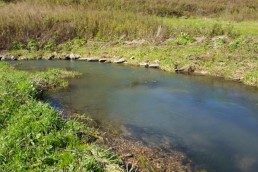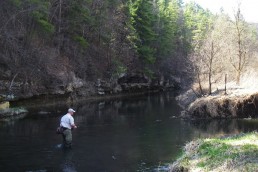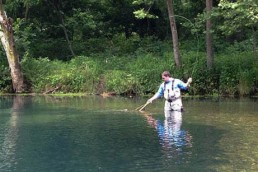Driftless Trout Stream Restoration
SHARE THIS POST
What are the best practices for trout stream restoration?
Stream restoration is a major player in the health of all of Midwest trout streams. It is certainly not a new concept. The practice has evolved over the seventy-plus years it has been used in the Driftless (the area where Minnesota, Wisconsin and Iowa meet).
Trout stream restoration, as a concept, is not overly complicated. However, the methods used by departments of natural resources, coldwater conservation organizations, and even private landowners do not come without scrutiny, strong opinions, and heavy criticism.
The story so far
Stream habitat restoration was started in Minnesota in the 1950s by the Minnesota Department of Natural Resources (MNDNR). By 1981, the Hiawatha Chapter of Trout Unlimited, under the leadership of Tom Dornack, got involved and started doing stream work on Trout Run Creek below Lohman’s Bridge. By 1986, the Hiawatha Chapter began an era of very successful stream restoration work on several miles of Crow Spring. Crow Spring is a tributary to the Middle Branch of the Whitewater, south and west of Whitewater State Park. Donack was the Hiawatha Chapter Stream Habitat Designer Coordinator from 1981 to 2008, and the MNTU State H.I. coordinator from approximately 2001 to 2008. He now works as a contractor for stream restoration projects throughout southeast Minnesota.
The mainstay of stream restoration completed in the 1980s to the 2000s was through the use of “lunkers,” “skyhooks,” and fortification of those structures and banks with rock. Wooden structures were built and placed in the stream to create overhead cover for trout. Those structures then had rock riprapped over the top of them and along the banks. Banks were sloped and reseeded to prevent erosion, and, ultimately, to hold the banks in place during periods of high water and flooding.
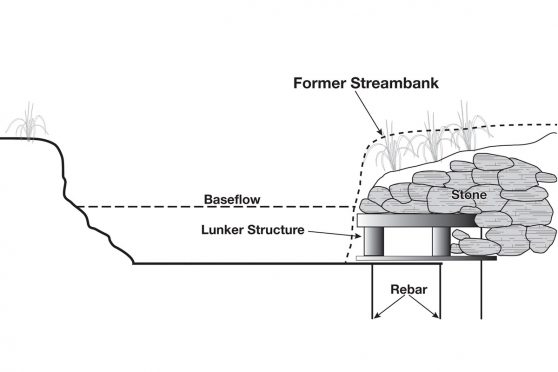
Changing methods
However, instream lunkers were phased out in favor of instream skyhooks which prevent tipping of the structure. Both have now been replaced as the primary methods of stream restoration throughout the Driftless area.
When asked why stream restoration tactics have changed, the MNDNR’s Ian Chisholm responded by saying, “To improve outcomes and performance, we continue to assess our application of these techniques. For example, in ‘traditional’ habitat projects, there has been an increased use of wood to provide habitat diversity, and to reduce the ‘cookie-cutter’ appearance of a project that only use riprap, weirs and artificial structures. This change in wood use is not being driven solely by DNR, but represents a recognition by consultants, federal agencies, and non-profits that wood in streams provides unique habitat.”
MNTU’s John Lenczweskis states, “Chapters active in southeast Minnesota habitat work (Hiawatha TU, TCTU, etc.) began shifting away from lunkers in the mid-2000s.” The Ecological Services division of the MNDNR is responsible for approving projects and approving design of stream habitat improvement projects throughout southeast Minnesota. It is the driving force behind the change in stream restoration tactics. Is the change in tactics benefiting the overall health of those streams? Producing quality habitat that will support trout and which is economically sound?
Is wood the way to go?
The wood approach to instream habitat improvement can be linked directly to Dave Rosgen. Rosgen is a hydrologist from Colorado. He developed the woody debris approach to stream restoration. He has his own private firm that travels the country and teaches classes to aspiring stream restorers who want to learn his method. Those trainees go back to their local waters and employ his methods.
One simple criticism of Rosgen as a trout stream restoration trainer is that those who take his course are not necessarily qualified to complete trout stream projects. When asked about the influence of the Rosgen approach, Chisholm responded, “Training in Applied Fluvial Geomorphology, including the Rosgen Classification system and in River Assessment and Monitoring and River Restoration, has been provided by our River Ecology Unit staff, and others, since the late 1990s. Dave Rosgen held his courses here in Minnesota from 2010 until 2016. Numerous DNR staff and others (private consultants and staff from other government units) were trained directly by him during this time.”
Comparable classifications?
One aspect of the Rosgen Classification system is to predict river behavior by appearance and give the stream a classification. This classification system was developed in Colorado for Colorado streams. It has spread across the west and even to the Midwest. One could ask, “Why is Minnesota embracing a stream restoration methodology developed in Colorado? Clearly comparing the two states and their rivers and streams does not seem logical.”
How is woody debris used in stream restoration? Wood is anchored in the channel to stabilize banks. It does not utilize the once-preferred method of using rock to stabilize stream banks. The use of instream wood is supposed to be well below water level, according to John Lenczewski, of MNTU.
Use of the Rosgen system does not come without criticism and negative outcomes. The main criticism is that the wood washes out of the stream easier than other methods during periods of high water.

Rising waters–a danger to the driftless
Dr. Mike Osterholm created a unique and viable stream restoration on his own Prairie Song Farm on Waterloo Creek in northeast Iowa. He says, “We have to recognize that we are in an era of historical high-water events in the Driftless. A great example of this was on Waterloo Creek which saw 29.7 inches of rain from August 15 to September 15, 2016. The August 15 to September 15, 2017 total, by comparison, was .7 inches. Climate change is massively impacting our watersheds and any stream work that is being done in those watersheds.”
Simply put, the Rosgen method does not have staying power against high water and flooding conditions. It washes away, leaving the project area destroyed. Dornack’s assessment of recent Rosgen/woody debris projects throughout southeast Minnesota is nothing short of disappointing.
Four years ago, Dave Vetrano and the rest of the Wisconsin DNR trout habitat guys toured the Cold Spring Brook project. They took along Minnesota Trout Unlimited, Hiawatha Trout Unlimited, along with Duke Welter and Jeff Hastings from the TU Driftless area office. Dave said, “The money spent on the Cold Spring Brook project would have been better spent if it were thrown out a car window.” The other Wisconsin DNR guys stated that it was one of the worst projects they had ever seen.
Wood anchoring still on the table
Despite some negative outcomes, there are stream restoration projects still happening that utilize woody debris. The DNR admitted that there has never been any long-term monitoring of Rosgen projects. When pressed on the issue of the Rosgen method, Hiawatha Trout Unlimted’s stream coordinator, Paul Krolak, stuck to his guns: “We’ve seen far less failure with wood than rock. And a better tendency to naturally narrow the stream when the bank doesn’t have rock pounded into it. We’ll monitor the performance of both, going forward, but we won’t stop putting wood into the streams.”
Native prairie grass anchoring systems
Osterholm, an epidemiologist by trade, bought a piece of water on Waterloo Creek. He hired a fleet of trucks to haul out more than 300 dumptruck loads of sediment that had piled onto the property. Then, he culled back all trees within several hundred yards of the stream. This then recreated the native prairie biome as well as a corridor of free-flowing water in the event of major flooding. This tactic is completely contradictory to the stream models used by the MNDNR and TU. They use a variety of instream structures which can ultimately create areas of log jams. Those log jams, in turn, create erosion which washes away precious stream banks and vegetation.
Dr. Osterholm then proceeded to slope the banks and plant native prairie grass as an anchor. In the event of major flooding, which can be a common occurrence in the Driftless, the banks would not wash out. Native grasses would hold them in place. Any debris that flowed into the property could keep flowing. With no debris, the channels, runs, and riffles would remain clear. Unlike the Rosgen method, and hard-armoring lunkers and rock, Osterholm did not embed any wood, root wads, or rocks for stabilization of Waterloo Creek. The prairie grass became the sole source for bank stabilization.
Osterholm had previously personally funded and implemented all of the same tactics that TU and the DNR employ. All failed.
Are you enjoying this post?
You can be among the first to get the latest info on where to go, what to use and how to use it!
The maintenance for prairie grass restoration projects is relatively simple, but also extremely effective. Each spring, the property is burned to rejuvenate the native grasses. This also stamps out any invasive species that may be present.
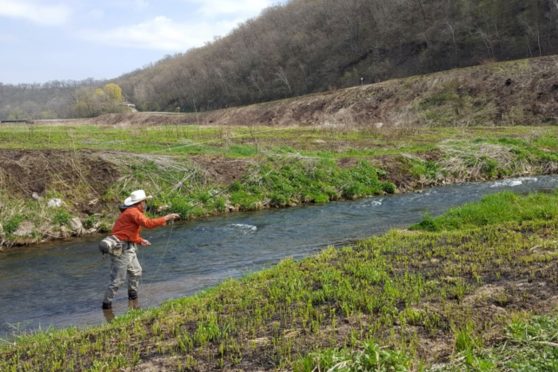
Grass not a go
Osterholm was extremely generous towards MNTU and any person of interest who wanted to fish his project. He volunteered to speak at numerous functions and provide long-term photographic and video evidence. Members of the local Hiawatha Chapter spent numerous occasions there, but never embraced prairie grass restoration. Neither has Minnesota Trout Unlimited’s state council. Several board members have had the opportunity to see the impact prairie grass has had on Waterloo Creek. Yet, none of them are a driving force behind changing the trend away from the Rosgen woody debris method.
Osterholm observes that no evaluation of streamwork over time and over major flooding events is being done. DNR and TU have no systematic evaluation to gauge the successes and failures of their work. Osterholm estimates that he could have saved 90 percent of his money that went into the PSF project by never using woody debris or skyhooks.
Taking a deeper look
The DNR’s Chisholm’s thoughts on evaluation: “Although DNR has not done a comprehensive study, we have no evidence to suggest that projects where a full restoration was done are inferior to sites using traditional methods with regards to trout abundance or size.”
MNTU President John Lenczewski disagrees with Chisholm: “We perform detailed surveys of each project site as part of the design process, and again after construction is completed. The surveys gather data on pool depths, channel width, type of exposed substrate, etc. The post-construction survey documents the initial habitat improvements and provides the baseline to evaluate changes over time. Repeating the survey five or more years later should provide data to assess how well it is working over time.”
Whether Chisholm or Lenczewski is correct, there is no evidence to suggest that streams with inferior stream work being reworked will fix any problems that arose from the actual project itself. Dornack agrees with Chisholm, “There are zero new Rosgen/woody debris projects that have been evaluated in southeast Minnesota. Seriously, would you not think that at least one stream was evaluated? There is a vast difference in the kind of stream work being done but no evaluations. The question is, why?”
One size does not fit all
Osterholm’s best practices on Prairie Song Farm, after a trial and error process, were to solidify the stream banks and create a better floodplain. The energy of the water then creates less sedimentation and deeper pools, naturally. The Rosgen approach, in his words, is “a cookie cutter approach.” The soils that Rosgen projects are being done on out West are very different than the soils of the Driftless area. Just like the sand streams of Eastern Wisconsin are very different than the Driftless area. “What works on those sand streams does not work on the black-dirt-laden streams of the Driftless area.”
Osterholm feels stream work gets too hung up on academic knowledge versus trial and error. The DNR doesn’t like to be challenged by people like Osterholm who have never been trained in it. “Why are guys from out West (Rosgen) telling Midwesterners how to do stream work?”
Proven results
What was the final product on Waterloo Creek? A stream with sloped banks anchored in place by native grasses. Those grasses prevent major erosion during times of major flooding. Waterloo Creek continued to flush out sediment that often gathers and chokes Driftless streams. Less sediment enabled higher stream flow which ultimately deepened pools. Deeper pools then encouraged a biomass of aquatic insects and terrestrials, allowing trout to thrive.
The downside to prairie-grass-habitat-based stream improvement lies within the maintenance. Grasses need to be routinely burned or grazed in order to be effective. Currently, there is no budget for the continued maintenance that prairie grass requires on public lands. Osterholm privately funded and maintained his property, so it to continues to be a viable method.
So, what does Osterholm see as the best solution? Work done by multiple non-controversial parties, and stream work that moves forward as a discipline. “There needs to be a systematic evaluation of habitat improvement. An auditing system that looks at stream work before, during and after flooding as a means of measuring best practices.”
Wood simply no good
Dornack, a stream restoration expert, is more pointed in his assessment: “Please, keep in mind all types of trout habitat work require some maintenance. That includes using native prairie grasses. The difference is, woody debris projects are flat-out bad projects right out of the gate. They provide little, if any, real habitat for trout or other species, are not fishable, and usually have major maintenance problems right away—and often.”
In the end, the MNDNR and MNTU continue to embrace the Rosgen woody debris method. Taxpayer money, and money generated via the Lessard-Sams Outdoor Heritage Council in the form of grants, continues to pour in to fund these projects. They might or might not work. As Dornack points out, “There is plenty of electro-fishing data that proves traditional habitat improvement (skyhooks and rock) has improved stream function and trout populations.”
There is little to no formal evaluation of current stream restoration methods that incorporate the Rosgen method. Embracing a stream restoration plan from a hydrologist from Colorado to implement in the Karst Driftless topography makes little to no sense whatsoever.
Once a project is completed, there is little to no chance that it will ever see more rehabilitation again. Nor will it be evaluated for its effectiveness in purpose and design. Strange, considering the millions of dollars and man hours that are put into such a task.
Dave Anderson has lived in southeast Minnesota his entire life. He started fly fishing in the early 1990s and has guided ontheflyguiding.com in the area since 1998.
MWO
SHARE THIS POST
Did you enjoy this post?
You can be among the first to get the latest info on where to go, what to use and how to use it!
Dave Anderson
Dave Anderson has lived in southeast Minnesota his entire life. He started fly-fishing in the early 1990s and has guided ontheflyguiding.com in the area since 1998.
